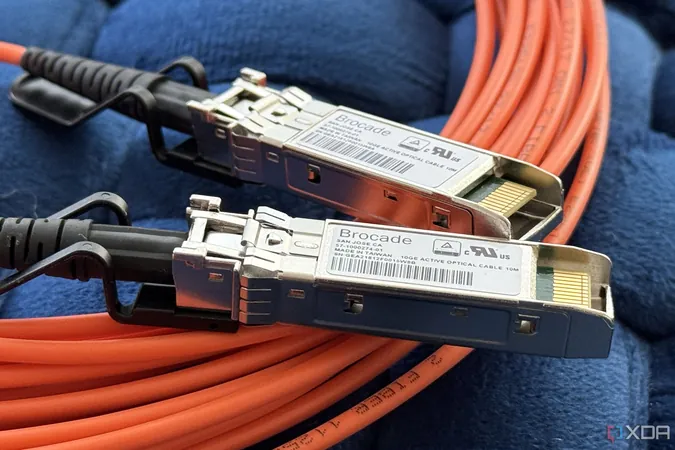
Unlock Your Home Network: 6 Game-Changing Differences Between SFP+ and RJ45
2025-08-17
Author: Noah
Upgrade Your Home Network!
Is your home network ready for a boost? While most homes rely on the familiar RJ45 Ethernet ports, there's a world of high-speed potential waiting with SFP+ (Small Form-factor Pluggable Plus). If you crave lightning-fast internet and ultra-low latency, it's time to explore how SFP+ can transform your setup. But beware! Hasty purchases could leave you with expensive modules that just won't work with your existing RJ45 devices.
1. Design and Size: Spot the Difference!
At first glance, SFP+ transceivers are small, rectangular modules that stand out from standard RJ45 ports. While RJ45 connectors are universally found on all kinds of devices—from laptops to game consoles—SFP+ requires specific compatible hardware like routers and switches. The RJ45, with its eight-pin setup, has become the mainstream choice for home networking, but don’t expect it to be hot-swappable like SFP+.
2. Compatibility: Not All Routers Are Created Equal!
If you're planning to incorporate SFP+, prepare to upgrade your router! Many standard home routers don't support SFP+ ports, meaning you'll likely need a high-end Wi-Fi 7 router or prosumer-grade equipment. Meanwhile, RJ45 connectors let you plug and play across devices with zero hassle, making them more accessible for everyday users.
3. Heat Generation and Power Consumption: Stay Cool!
SFP+ modules can be a game-changer for heavy data users. While standard RJ45 ports efficiently handle speeds of up to 1Gbps, SFP+ can push that to 10Gbps without overheating—perfect for streaming 4K and 8K video. Remember, however, that running old Cat5e cables can lead to increased power costs and signal loss. In contrast, SFP+ shines with fiber optic cables by staying cool and consuming less power.
4. Speed and Interference: Elevate Your Experience!
For those seeking top-tier speeds, SFP+ is the way forward, especially if your ISP offers fiber connections. If you're diving into activities like video editing or setting up a home lab, the reduced electromagnetic interference with SFP+ becomes a crucial advantage. Unlike RJ45, which can suffer from signal degradation near electrical sources, SFP+ keeps your connection steady.
5. Safety First: Avoid Electrical Hazards!
When it comes to safety, SFP+ wins hands down. With its optical fiber cables, SFP+ is immune to electrical surges and lightning strikes, making it a safer choice for indoor and outdoor installations. In contrast, RJ45 Ethernet cables, which carry electrical current, can be vulnerable to damage and safety hazards, especially in poorly shielded setups.
6. Cost Considerations: Invest Wisely!
It's important to consider your budget when choosing between SFP+ and RJ45. While SFP+ comes with a higher price tag for modules and cables, investing in second-hand gear can make it more feasible for home labs. RJ45 cables, on the other hand, are generally inexpensive and readily available, making them the go-to choice for everyday home networking.
Build Your Future-Proof Home Network!
Whether you're looking to enhance your streaming experience or build a powerful home lab, understanding the differences between SFP+ and RJ45 is essential. So, dive in, choose wisely, and get ready to enjoy an energized, future-proof home network!









 Brasil (PT)
Brasil (PT)
 Canada (EN)
Canada (EN)
 Chile (ES)
Chile (ES)
 Česko (CS)
Česko (CS)
 대한민국 (KO)
대한민국 (KO)
 España (ES)
España (ES)
 France (FR)
France (FR)
 Hong Kong (EN)
Hong Kong (EN)
 Italia (IT)
Italia (IT)
 日本 (JA)
日本 (JA)
 Magyarország (HU)
Magyarország (HU)
 Norge (NO)
Norge (NO)
 Polska (PL)
Polska (PL)
 Schweiz (DE)
Schweiz (DE)
 Singapore (EN)
Singapore (EN)
 Sverige (SV)
Sverige (SV)
 Suomi (FI)
Suomi (FI)
 Türkiye (TR)
Türkiye (TR)
 الإمارات العربية المتحدة (AR)
الإمارات العربية المتحدة (AR)